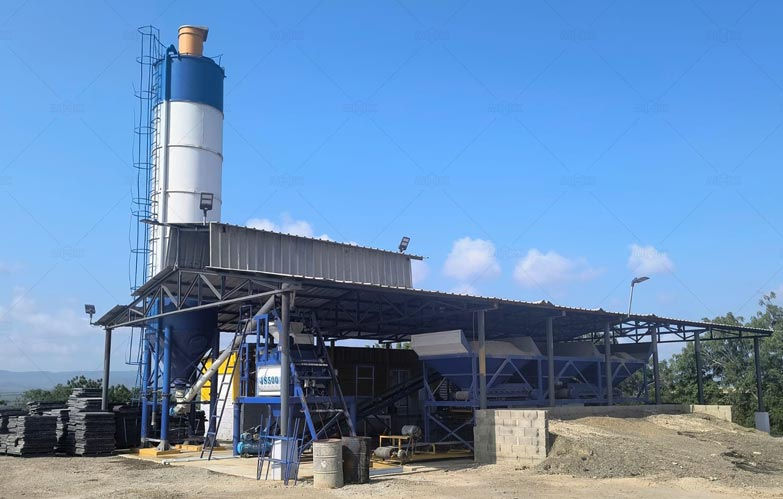How to Ensure the Long-Term Safe Operation of Mobile Concrete Plants Through Standardized Operations?
- Aimix maquina

- 4 jun
- 3 Min. de lectura
In the construction industry, the efficiency and safety of mobile concrete plants are critical for delivering high-quality concrete for a wide range of construction projects. The mobile concrete plant, offering flexibility, mobility, and fast setup, has become a popular choice for many construction sites. However, ensuring its long-term safe operation requires implementing standardized operations. These standards not only optimize performance but also minimize risks, reduce downtime, and extend the lifespan of the equipment. Below, we explore key strategies to guarantee the safe and efficient operation of mobile concrete plants.
Importance of Standardized Operations for Mobile Concrete Plants
Operating a mobile concrete plant(planta de concreto móvil precio) involves various intricate processes, including mixing, transport, and delivery of concrete. A failure in any of these stages can lead to safety hazards, environmental damage, or operational delays. This is why adhering to a well-established set of operational standards is vital. A standardized approach ensures that all procedures are followed, safety protocols are in place, and each team member is adequately trained to handle the equipment.
Standardized operations cover everything from maintenance routines to safety checks, and they are crucial in minimizing the risk of equipment failure, improving product consistency, and meeting regulatory requirements. For mobile concrete plants, it’s important to understand how these standardized operations translate into long-term safety and performance.

Regular Maintenance and Inspections
One of the most essential aspects of safe operation is regular maintenance and inspection of the mobile concrete plant. Inspections should be conducted frequently to identify any wear and tear, potential malfunctions, or safety hazards before they cause operational downtime. A mobile concrete plant, whether it's a large model or a more compact mini concrete plant(mini planta de hormigon), requires routine checks of critical components such as the mixing unit, conveyor belts, and electrical systems. These checks should include the following:
1. Checking for Mechanical Issues
Regularly inspect parts like the mixer drum, power transmission system, and hydraulic systems to prevent malfunctioning. If any abnormal noises or vibrations are detected, they should be addressed immediately to prevent further damage.
2. Monitoring Electrical Systems
Electrical malfunctions can be dangerous, so ensuring the wiring and electrical systems are regularly checked and repaired as needed is key. Ensuring that the control panel is working properly and there are no exposed wires or faults is essential for safe operation.
3. Evaluating Safety Features
Safety devices like emergency shutoff switches, alarms, and automated system shutdown features should be inspected regularly. These are vital for preventing accidents in case of system malfunctions.
Training and Certification for Operators
Training plays a significant role in ensuring the safe operation of a mobile concrete plant. Operators must undergo proper training to understand the functionalities of the plant and how to deal with various situations that could arise on the job site. This includes knowing how to operate the equipment, perform regular checks, and respond to emergencies.
Having certified operators ensures that the concrete plant(planta hormigonera) runs smoothly and safely. They should be well-versed in understanding plant schematics, mixing ratios, troubleshooting issues, and complying with safety regulations. Training should also include educating workers on maintaining the cleanliness of the plant, keeping materials and parts organized, and performing basic maintenance tasks.
Regular Refresher Courses
Standardized operations aren’t limited to initial training; operators should attend regular refresher courses. These courses should focus on new technologies, updated safety protocols, and any regulatory changes that impact the operation of mobile concrete plants.
Utilizing Technology for Monitoring and Maintenance
Technology can play a crucial role in ensuring the long-term safe operation of concrete plants. Modern mobile concrete plants come equipped with advanced sensors, monitoring systems, and control software. These systems can provide real-time data about the health and performance of the plant, allowing operators to make informed decisions about maintenance and repairs.
Remote Monitoring and Diagnostics
Many mobile concrete plants now have remote monitoring capabilities, which allow manufacturers and operators to monitor plant performance remotely. This can provide early warnings for potential problems, reducing the likelihood of breakdowns and improving the overall safety of the operation.
Automated Maintenance Reminders
Automated systems that provide reminders for scheduled maintenance tasks can help prevent missed inspections or repairs. These systems ensure that key parts of the mobile concrete plant are serviced on time, reducing the chances of accidents caused by neglected maintenance.

Conclusion
Ensuring the long-term safe operation of a mobile concrete plant involves more than just following a set of procedures—it’s about fostering a culture of safety and maintenance within the organization. Standardized operations, regular maintenance, operator training, and the use of technology all contribute to keeping mobile concrete plants, whether it's a large concrete plant or a mini concrete plant, functioning at their best. By adhering to these best practices, construction companies can enhance safety, reduce costs, and ensure that their mobile concrete plants continue to serve their purpose efficiently for years to come.



Comentarios